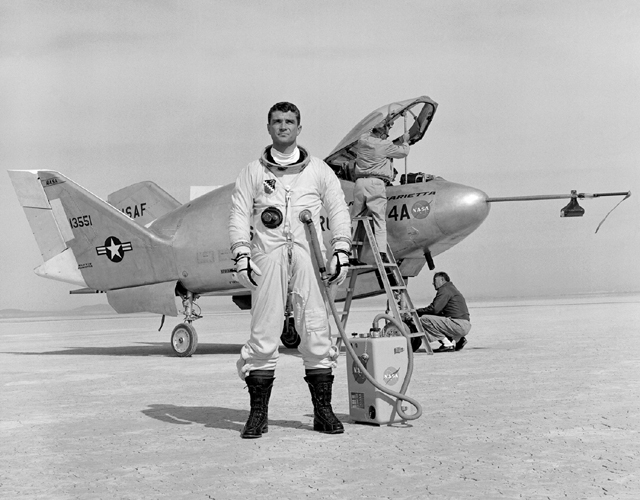Space History Photo: Pilot Major Cecil Powell and the X-24A on Lakebed

In this historical photo from the U.S. space agency, Air Force pilot Major Cecil Powell stands in front of the X-24A after a research flight in January of 1971.
Built for the Air Force by Martin Marietta, the X-24A was a bulbous vehicle shaped like a tear drop, with three vertical fins at the rear for directional control. It weighed 6,270 pounds, was just over 24 feet long, and had a width of nearly 14 feet. The first unpowered glide flight of the X-24A was on April 17, 1969. The pilot was Air Force Major Jerauld Gentry. Gentry also piloted the vehicle on its first powered flight March 19, 1970.
It was flown 28 times in a program which, like the HL-10, helped validate the concept that a space shuttle vehicle could be landed unpowered. Fastest speed in the X-24A was l,036 mph (Mach 1.6). The pilot was John Manke, who also reached the highest altitude in the vehicle, 71,400 feet. He was also the pilot on its final flight June 4, 1971. The X-24A was later modified with a different nose configuration and became the X-24B.
Each weekday, SPACE.com looks back at the history of spaceflight through photos (archive).
Get the Space.com Newsletter
Breaking space news, the latest updates on rocket launches, skywatching events and more!
Join our Space Forums to keep talking space on the latest missions, night sky and more! And if you have a news tip, correction or comment, let us know at: community@space.com.

The National Aeronautics and Space Administration (NASA) is the U.S. government agency in charge of the civilian space program as well as aeronautics and aerospace research. Founded in 1958, NASA is a civilian space agency aimed at exploring the universe with space telescopes, satellites, robotic spacecraft, astronauts and more. The space agency has 10 major centers based across the U.S. and launches robotic and crewed missions from the Kennedy Space Center in Cape Canaveral Florida. It's astronaut corps is based at the Johnson Space Center in Houston. To follow NASA's latest mission, follow the space agency on Twitter or any other social channel, of visit: nasa.gov.
